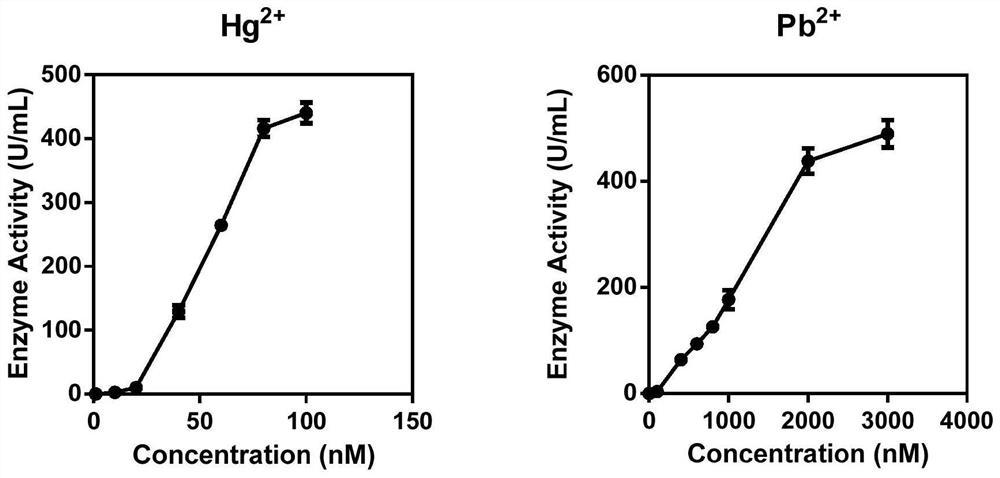Whole-cell biosensor for detecting heavy metal ions in water-soluble samples and its construction and application
A heavy metal ion, biosensor technology, applied in the field of environmental biology, can solve the problems of long detection cycle, long maturity time, and the instrument is not easy to carry.
- Summary
- Abstract
- Description
- Claims
- Application Information
AI Technical Summary
Problems solved by technology
Method used
Image
Examples
Embodiment 1
[0084] Example 1 Obtaining of Heavy Metal Ion Response Recombinant Bacteria
[0085] Using pSB1C3 as the starting vector (iGEM, http: / / parts.igem.org / Part:pSB1C3), a heavy metal responsive vector was constructed. The schematic diagram of heavy metal responsive carrier construction is as follows: figure 1 shown. The specific construction method is as follows:
[0086] 1. Synthesize the response protein and bidirectional promoter sequence (SEQ ID No.1 and SEQID No.2) of mercury and lead ion response respectively, the sequence from 5' to 3' is EcoRI, NotI, XbaI, response protein reverse complement Encoding genes, bidirectional promoter, SpeI, NotI and PstI.
[0087] 2. Synthetic cleavage gene SRRz, its sequence is shown in SEQ ID No.3, and the sequence from 5' to 3' is EcoRI, NotI, XbaI, SRRz cleavage gene, SpeI, NotI and PstI.
[0088] 3. Synthetic terminator T rrnB , its sequence is shown in SEQ ID No.4, and the sequence from 5' to 3' is EcoRI, NotI, XbaI, T rrnB Terminat...
Embodiment 2
[0095] Example 2 Cell Lysis Efficiency Rapid Detection of Sample Heavy Metal Ion Concentration
[0096] 1. Recovery and activation of recombinant E. coli
[0097] The recombinant Escherichia coli was streaked on the LB plate medium from the -80°C refrigerator, and cultured at 37°C for 14h. A single colony was picked, inoculated into LB medium, and cultured at 37°C and 220rpm for 12-16h.
[0098] 2. Preparation of Escherichia coli detection solution
[0099] Inoculate the resuscitated and activated bacterial solution into fresh LB medium at a volume ratio of 1:50, and cultivate to OD at 35-37°C and 220rpm 600 When the temperature reaches 0.4~0.8, add 0.1mM IPTG to the Erlenmeyer flask, continue to cultivate for 0.5h, and obtain Escherichia coli detection solution.
[0100] 3. Contact with the test sample
[0101] The E. coli detection solution in the Erlenmeyer flask was divided into different test tubes, 5 mL in each test tube, 10 μL of the test sample was added into the t...
Embodiment 3
[0116] Example 3 Combined with the semi-quantitative rapid detection of heavy metal ion gel by chromogenic gel method
[0117] 1. Chromogenic gel preparation
[0118] 1.1 Add 0.4g agar powder to 20mL Z buffer, heat it in a microwave oven to dissolve and keep it warm in a 70°C water bath for later use.
[0119] 1.2 Add 40 mg / mL X-gal solution to the above solution to a final concentration of 1 mg / mL, mix well, pipette 200 μL into a 96-well plate, cool and solidify at room temperature, and store at 4°C for later use. It can be stored for more than 3 months.
[0120] 2. Draw standard curve of chromogenic gel
[0121] According to steps 1-3 of Example 2, the test bacteria were activated, cultured and contacted with the sample to be tested. Take 10 μL of the bacterial solution and add it to the well containing the detection gel, and incubate at 37°C for 30min. With different concentrations of metal ions, the gel will show different shades of blue ( Figure 4 ).
[0122] Use t...
PUM
 Login to View More
Login to View More Abstract
Description
Claims
Application Information
 Login to View More
Login to View More - R&D
- Intellectual Property
- Life Sciences
- Materials
- Tech Scout
- Unparalleled Data Quality
- Higher Quality Content
- 60% Fewer Hallucinations
Browse by: Latest US Patents, China's latest patents, Technical Efficacy Thesaurus, Application Domain, Technology Topic, Popular Technical Reports.
© 2025 PatSnap. All rights reserved.Legal|Privacy policy|Modern Slavery Act Transparency Statement|Sitemap|About US| Contact US: help@patsnap.com



